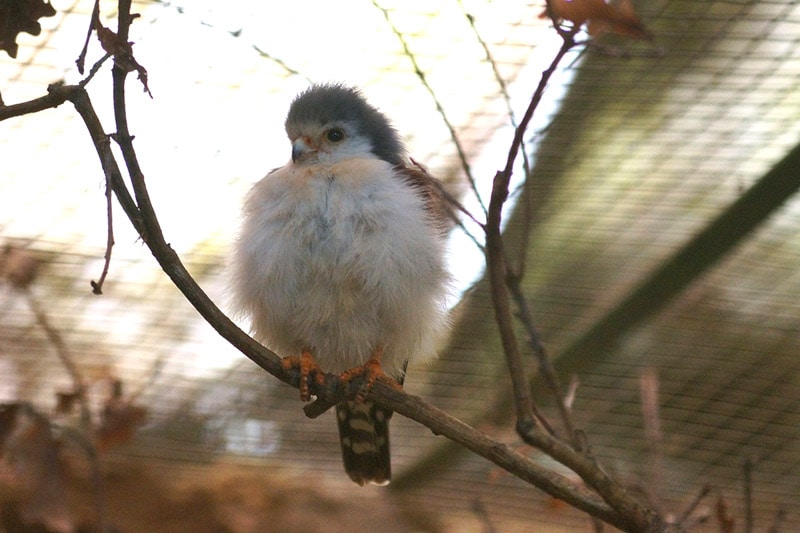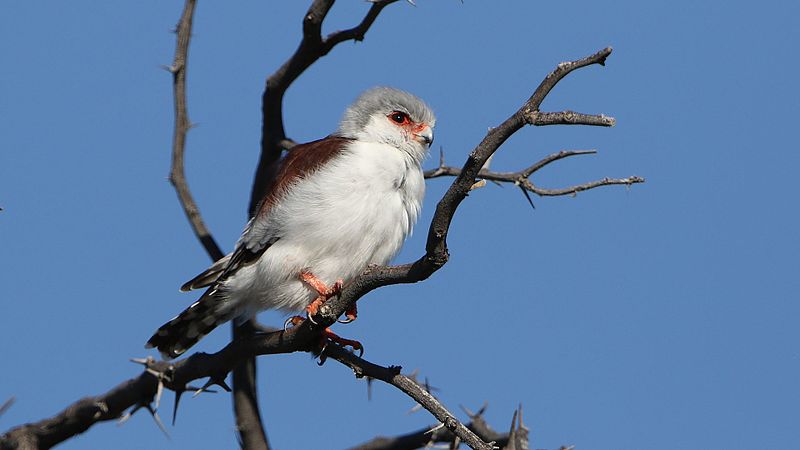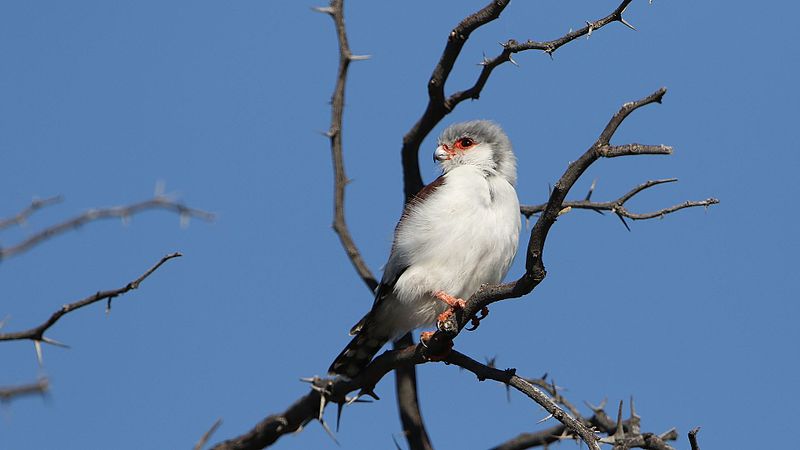Pygmy Falcon – Field Guide, Pictures, Habitat, and Info
Last Updated on

When we think of birds of prey, we usually think of bald eagles, red-tailed hawks, and peregrine falcons. But there are some species that fly under the radar, with some interesting features that no other aerial critters have. One of those species would undoubtedly be the pygmy falcon, an incredible bird endemic to Africa’s pristine wilderness. Let’s find out what makes this falcon so unique!

Quick Facts About Pygmy Falcons

| Habitat: | Flat, arid grasslands/shrublands |
| Diet: | Reptiles, rodents, small birds, insects |
| Behavior: | Aerial hunter |
| Nesting: | Weaver nests |
| Conservation: | Low-risk |
| Scientific name: | Polihierax semitorquatus |
| Lifespan: | 6 to 8 years |
Pygmy Falcon General Description
Better known as the African pygmy falcon, this apex bird is covered in a distinct pattern of red, white, and gray feathers across its body. Its back and wings are a reddish-brown color, with its belly and throat painted in cream white. The outer edges of the pygmy falcon’s eyes are a yellow and orange color, contrasted with black pupils and a gray crown. The species is quite small for a falcon, as they have a compact and fluffy plumage.
Pygmy Falcon Range, Habitat, Behavior, Diet & Nesting

Range
As the name suggests, it’s a resident of Africa—namely the eastern and southern regions of the continent. Pygmy falcons can be seen in countries such as Ethiopia, Kenya, Tanzania, and Somalia to the east as well as Namibia and Angola to the south.
Habitat
This falcon species inhabits dry, grassy biomes where they have open space to scout for food. These flat, dry regions are full of reptiles, rodents, and other small birds. However, the trees are quite spread out, so nesting spaces are limited.
Behavior
Head and tail gestures are the primary ways that pygmy falcons communicate physiologically. This may be head-bobbing (up and down) or tail shakes (side to side). Their hunting tends to be during dusk or dawn and they use aerial tactics to catch prey.
Diet
The pygmy falcon is a predatory bird that hunts reptiles (lizards, snakes, etc.), small birds, rodents, and insects. The African wilderness is plentiful with wildlife, but this bird’s size makes it less powerful than other birds of prey. These falcons rely on their agility and diving to catch food unexpectedly.
Nesting
Due to their range similarities, pygmy falcons take the nests of white-headed buffalo, red-billed buffalo, and sociable weavers. This is a huge benefit to their energy consumption, as they can take over pre-built nests without needing to build them with natural resources.


How to Find Pygmy Falcons: Birdwatching Tips
What to Listen For
The pygmy falcon’s call is high-pitched as they make a ‘kick-kick-kick’ that quickly increases in frequency. It’s also wise to listen for chipping sounds; but don’t forget to listen to rustling leaves or the sound of nearby prey.
What to Look For
When out in the Serengeti or shrublands, seek out any trees that may be a home for the pygmy falcon. One issue with the pygmy falcon is its small size, which makes it difficult to spot compared to other birds of prey. Keep your eyes peeled for nests, and the reddish-orange color contrasted with their white feathers.
When to Look
The best time to find them in action is during dusk and dawn. At this time, it’s likely that you will see them swooping down to hunt prey and returning to their nest. This can be great to find out where other pygmy falcons are situated.

Attracting Pygmy Falcons to Your Backyard
Unfortunately, pygmy falcons are not backyard birds. They are exclusively found in protected African parks, which are the only means of getting to see them in person. Additionally, their nesting is situated in very specific areas and they will not relocate unless their environment becomes unsuitable.
Pygmy Falcon Conservation: Is This Bird Threatened?
The pygmy falcon isn’t exactly endangered, as there is an estimated 100,000 to 1 million total in the wild. However, deforestation is their main concern, as trees aren’t plentiful in shrublands. Not only that, but due to their reliance on weaver nests, any effects of that species can ultimately impact the falcon as well. Luckily, white-headed buffalo weavers have a stable population.

Final Thoughts
Pygmy falcons are the smallest bird of prey in Africa, but that doesn’t make them weak predators. They are willing to sacrifice themselves to protect their young and their size-to-strength ratio is impressive. This species’ colors and body type make for a worthwhile birding experience. Not many people in the west have been able to witness them in person – so take a trip to the Serengeti to see one for yourself!
Featured Image Credit: 4011396, Pixabay
About the Author Robert Sparks
Robert’s obsession with all things optical started early in life, when his optician father would bring home prototypes for Robert to play with. Nowadays, Robert is dedicated to helping others find the right optics for their needs. His hobbies include astronomy, astrophysics, and model building. Originally from Newark, NJ, he resides in Santa Fe, New Mexico, where the nighttime skies are filled with glittering stars.
Related Articles:
10 Types of Hummingbirds in Arkansas (With Pictures)
8 Types of Hummingbirds in Nebraska (With Pictures)
5 Types of Hummingbirds in Idaho (With Pictures)
3 Types of Hummingbirds in Mississippi (With Pictures)
8 Types of Hummingbirds in Kansas (With Pictures)
5 Types of Hummingbirds in West Virginia (With Pictures)
5 Types of Hummingbirds in Ohio (With Pictures)
Where Do Nuthatches Nest? Nuthatch Nesting Habits Explained
